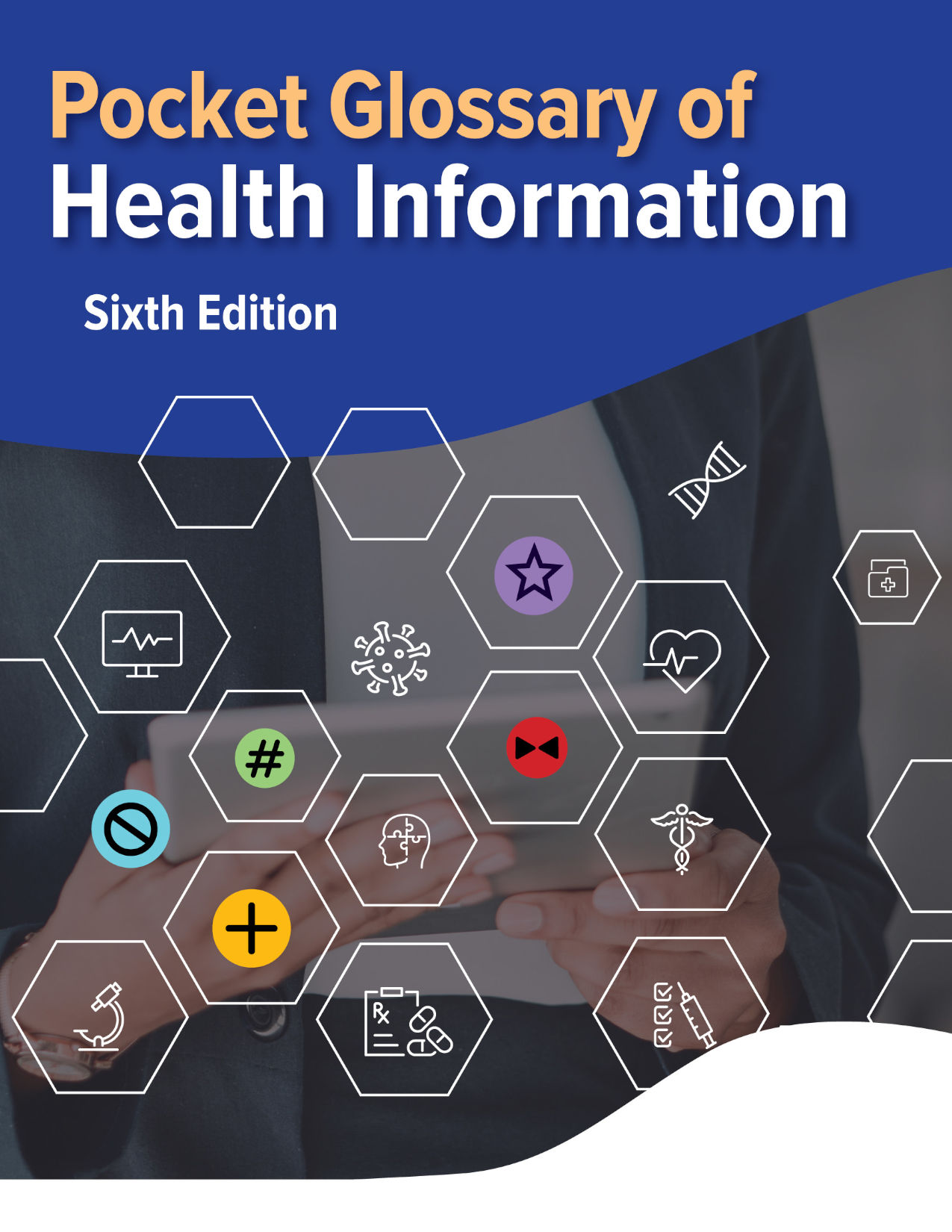April Insco, PhD, RHIA, CCS, CHDA, CPC-I, CPHI, appreciates having valuable information at her fingertips.
That’s why she uses a medical terminology book that she keeps on hand to look up abbreviations when needed. And that’s why she sees great value in health information (HI) professionals and students having the sixth edition of the AHIMA Pocket Glossary of Health Information.
 Insco worked as a technical editor on the new edition of the Pocket Glossary with Melissa Koehler, DHA, MBA, RHIA, CCDS, CCS, CCS-P, CDIP, CHDA, CRCR, CSBI, CSPR, FAHIMA. The 264-page book is available now from AHIMA and includes essential terms from foundational and emerging health information management (HIM) and health information technology (HIT) topics.
Insco worked as a technical editor on the new edition of the Pocket Glossary with Melissa Koehler, DHA, MBA, RHIA, CCDS, CCS, CCS-P, CDIP, CHDA, CRCR, CSBI, CSPR, FAHIMA. The 264-page book is available now from AHIMA and includes essential terms from foundational and emerging health information management (HIM) and health information technology (HIT) topics.
“It’s an important resource to have because you have a lot of what you need as far as the terminology right there in a pocket glossary in one place. You don’t have to worry about your internet being down,” says Insco, a professor and program director of the AAS HIM program, the AAS medical informatics program, and the medical coding certificate program at Roane State Community College.
Unique and critical terms from the fields of information governance, data analytics, and health informatics are also defined and described in the glossary, making this an essential reference tool for HI practitioners, educators, students, researchers, and any healthcare professional with an interest in HI practice.
“It’s ideal as a quick-reference when encountering unfamiliar terms, a fact-checker to confirm correct usage, and a teaching tool for onboarding new staff or orienting colleagues outside of HIM,” says Koehler, AVP of Health Information Management at Inova Health System. “It can also be used to support communication with executives, clinicians, and IT professionals by providing standardized, industry-accepted definitions.”
The Importance of the Pocket Glossary
Key features of the new edition:
- More than 3,800 terms at your fingertips
- More than 165 revised terms
- Excellent accompaniment to AHIMA foundational HIM and HIT textbooks
- Includes citations and a complete reference list
“HI professionals work at the intersection of clinical care, data management, compliance, and technology,” Koehler says. “Precise, consistent terminology ensures we are all speaking the same language—whether we are coding records, interpreting regulations, implementing systems, or collaborating across disciplines. The glossary is a reliable foundation for that shared understanding.”
Are new emerging areas such as artificial intelligence (AI) addressed in the glossary?
“Yes—this edition includes terminology related to artificial intelligence, machine learning, natural language processing, and automation,” Koehler says. “These terms are critical as HI professionals increasingly evaluate, adopt, and optimize technology solutions that leverage these capabilities in documentation, coding, analytics, and workflow design.”
Insco has served as a technical reviewer on textbooks and was glad to help when asked to work on the glossary. She invited her long-time friend and colleague Koehler to collaborate with her as technical editors.
 “We’ve worked together in various capacities over the years, and this was an opportunity to combine our expertise and ensure the glossary reflects both the foundational knowledge of HIM and the terminology shaping its future,” Koehler says.
“We’ve worked together in various capacities over the years, and this was an opportunity to combine our expertise and ensure the glossary reflects both the foundational knowledge of HIM and the terminology shaping its future,” Koehler says.
Insco and Koehler reviewed all of the glossary terms and references to make sure they are still valid.
“We did have quite a few changes,” Insco says. “We had to update the references because some of the references were outdated, and we had to update different terminology."
“We removed a lot of the terms that we felt were very specific to coding and not necessarily the HI profession,” she adds. “And then we also removed some that we thought were too specific to IT.”
Koehler says, “This edition includes updated definitions to reflect current industry standards, new terms for emerging technologies, and refreshed acronyms and abbreviations. We placed special emphasis on clarity, accuracy, and readability—particularly in evolving areas like interoperability, value-based care, health informatics, and data governance—while maintaining the trusted format the glossary is known for.”
Insco says educators should make sure that HI students know the glossary is available as a resource.
“For someone going through our introduction to HIM class, it would be very beneficial for them to have this book at the palm of their hands to just say, ‘OK, what exactly does that mean?’ Insco says. “Sometimes, you’ll hear somebody talk about something or you’ll see something in passing, but it’s like, ‘I don’t understand what that terms means.’ Having the glossary would be helpful.”
Other Valuable Resources for HI Professionals and Students
In addition to the Pocket Glossary, AHIMA offers other publications that are designed to be trusted guides for HI professionals and students, filled with up-to-date content, best practices, and essential insights. AHIMA textbooks evolve with the healthcare landscape, continually updated to reflect new coding standards and guidelines. You can view the AHIMA Advance Fall 2025 Education Catalog online now.
Among the updated resources listed in the catalog is Health Information Management Technology: An Applied Approach, Seventh Edition, which transforms and enhances the education and training for HIM professionals. The content in this book supports the AHIMA current curricula, and the chapters are mapped to the AHIMA Registered Health Information Technician (RHIT) domains. The organization of the information provides students with a logical flow for skill development and knowledge building.
Key features of the new edition:
• Topical coverage expanded in the content areas of auditing, AI, compliance, and critical thinking
• Updated real-world cases at the end of each chapter present actual scenarios faced by HIM professionals and are designed to initiate discussions that will elaborate on chapter topics
• Updated Check Your Understanding questions throughout each chapter reinforce concepts to improve comprehension
• Appendix A contains answers and rationales for odd-numbered Check Your Understanding questions
• Downloadable student resources include a student workbook with real-world cases and case discussion questions, application exercises, and review quizzes.
The volume editors of Health Information Management Technology: An Applied Approach, Seventh Edition, are Nanette B. Sayles, EdD, RHIA, CCS, CHDA, CDIP, CPHI, CHPS, CPHIMS, FAHIMA, a professor in the health information management program at East Central College in Missouri; and Leslie L. Gordon, MS, RHIA, CPHQ, FAHIMA, former director of performance improvement for the Southeast Alaska Regional Health Consortium.
Damon Adams is content production editor for AHIMA.